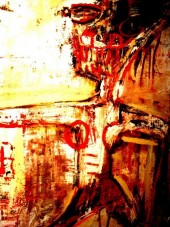Far from the mischievous "Kid" he played on Kids Incorporated 23 years ago, Rahsaan Patterson re-entered the music scene from behind the scenes penning perhaps Brandy's biggest single to date as well as session work for other well known artists. By the time he sought a record deal, there was a near bidding war over him. MCA won the battle in 1995 and by 1997; Rahsaan Patterson's self-titled debut was released.
Rahsaan Patterson was simultaneously retro and fresh the way neo-soul indeed was supposed to be. The difference though was that Rahsaan and collaborators Keith Crouch and Jamey Jaz didn't reach as far back as most neo-soulers. Crouch's funk sensibilities and Jaz's chord structures and bridges harkened to the very best of 80's R&B while every other product of the hip-hop that bred neo-soul fished for the Rhodes of Stevie and Donny, vibes of Roy , and upright bass of Ron. Patterson, Crouch, Jaz, and Les Pierce reminded R&B lovers of bridges and solos long since replaced by rap verses. But we mustn't dance around what pulled the average listener and locked in nearly vocalist in church or club - Patterson's voice. It was an itchy scratchy thing when he wanted it to be-like his pipes were silver-coil lined. It was a soaring falsetto when he wanted it to be. It was a funky ass tenor-bass when he wanted it to be. It was a nearly operatic alto when he wanted an exclamation point. What range is this?!! Who sings like this? One thing couldn't be denied by ANY true vocalist, in 1997, there was no male vocalist out who had the range and control of it that Rahsaan Patterson had.
Though he was as unique as any of the newly crowned "Neo-Soulers" of the late 90's, Rahsaan at MCA was very lost in the shuffle of corporate fools who didn't know how to "package," "market" or "promote" him. The truth is, his material was so top shelf that the markets that truly mattered to Black music, specifically in the adult category, were already spinning one if not two of his singles from the early EP and he didn't need the label to step in and do anything but support the momentum the quality recordings already came with. With an overly sexual Maxwell fresh on everyone's lips, minds, and hearts, EVERY man in the industry after Max HAD to have an image. MCA allowed their confusion and control over Patterson to inhibit otherwise gold/platinum material for reaching its full potential.
Despite MCA's shortcomings, Rahsaan Patterson's music made it to urban adult radio in enough markets to garner a truly loyal following who anxiously awaited the sophomore project after being thoroughly serenaded by the singles "Spend the Night" and "Where You Are," the latter remaining a show favorite for a decade to come.
Love in Stereo arrived in stores in late 1999 as neo-soul and R&B lovers anxiously awaited D'Angelo's Voodoo. As Voodoo was pushed back to Jan 2000, "Love in Stereo" had time enough to permeate the souls of any true R&B fan willing to listen. Much more up-tempo than his debut, LIS was a late 70's, early 80's tour de force reminiscent of Travolta disco, Natalie Colish happy jams, clav-filled Wonder-esque ditties, and some of the freshest vocal arrangements heard in years. The songwriting was more personal as well, humanizing Patterson to endearing fans. "Sure Boy," "It's Alright Now" and "Friend of Mine" invited us in to an apparently cerebral and complex man's mind and world. The jamming didn't stop though and the last half of the album was jamming ass "roll back the rug everybody" party. Despite the studio synergy of Patterson, Jaz and newly added Van Hunt & Steve "Silk" Hurley, MCA still found no way to deliver 1999's most important black album to a large public withering away from malnourishment.
For a moment there was urban contemporary hope for Rahsaan's 3rd project as spins were growing on the Steve Harvey compilation track "The One for Me." It was also to be the lead single from Patterson's project. For the first time, he had spins on major urban contemporary radio. Alas, the Music Cemetery of America, as Rahsaan's label mates, The Roots unaffectionately referred to the former 80's black music powerhouse, underwent a huge merger and were themselves retired by parent company Universal in 2003. In attempts to trim "fat," Interscope, now responsible for MCA's roster, dropped over 40 artists before re-instating the Geffen label. Rahsaan and his third project, initially titled The Best, were set "free" to fend for themselves in the open market. Though initially dismayed, Patterson and his management found solace in their new independence forming Artistry Music and renaming the label funded project, "After Hours."
For the third time, Patterson and Jaz delivered the purest rhythm & blues compositions, arrangements and productions since Jam and Lewis. "Don't Run So Fast" and "Sometimes You Gotta Let Go" were needed by the masses as they scrapped up the remains of the neo-soul movement searching for simply "good music." Van Hunt's former title cut "The Best" is perhaps the greatest composition of Patterson's to date. Add a dash of Hurley ("Yeah Yeah Yeah") and Patterson drummer/compadre D-Locc Walker ("April's Kiss" and "Always Find Myself") and "After Hours" ranks very solidly with Patterson's previous masterpieces. Rahsaan Patterson is a testament to triumph over adversity.
The music biz could easily have killed the spirit of an artist as pure and authentic as he is. The mere fact that we are welcoming his 4th studio effort is a feat that only one member of the 'neo-soul elite' managed to do. To continue pressing on without the support of all the pretty things that seem so necessary for artists to get heard these days is remarkable, but more importantly, inspiring.
- Reg Jones, The Blacklist
